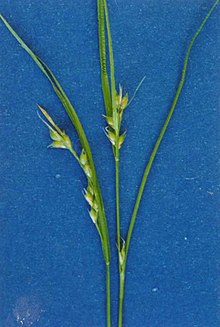Carex rossii
| Carex rossii | |
|---|---|

| |
| Scientific classification | |
| Kingdom: | Plantae |
| Clade: | Tracheophytes |
| Clade: | Angiosperms |
| Clade: | Monocots |
| Clade: | Commelinids |
| Order: | Poales |
| Family: | Cyperaceae |
| Genus: | Carex |
| Subgenus: | Carex subg. Carex |
| Section: | Carex sect. Acrocystis |
| Species: | C. rossii
|
| Binomial name | |
| Carex rossii | |
| Synonyms[1][2] | |
| |
Carex rossii, commonly known as Ross's sedge, is a hardy species of sedge that is often a pioneer species in areas with little or no established vegetation, or in places where disturbance has occurred. Ross's sedge grows in a variety of habitats throughout much of western North America, from Alaska to Ontario, south to New Mexico and California. It flowers in May and June.[3][4][5]
Taxonomy
[edit]Carex rossii was first described by Francis Boott in Hooker's Flora Boreali-Americana (1839). The type locality was listed as "Hab. N. W. Coast. Douglas. Rocky Mountains. Drummond" (sic)".[6]
Description
[edit]Carex rossii produces a dense clump, or solid mat of slender stems up to about 40 centimetres (16 in) from a shallow network of rhizomes. The pale to dark green leaves are usually longer than the stems. The inflorescences contain one or more staminate flower spikes above more rounded pistillate spikes. The fruit is three-sided, and covered in a greenish or brownish perigynium.[3][4]
Distribution and habitat
[edit]Carex rossii is native to, and sometimes abundant in, Alaska and subarctic Canada (Nunavut, Northwest Territories, and Yukon Territory); western Canada (Alberta, British Columbia, Manitoba, and Saskatchewan); and the contiguous U.S. (Arizona, California, Colorado, the Dakotas, Idaho, Minnesota, Montana, Nevada, New Mexico, Oregon, Utah, Washington, and Wyoming.) It is found only sporadically in Ontario, Michigan, and Nebraska.[2][3][7]
It grows in many habitat types, including wet and dry areas in forest, sagebrush, prairie, and alpine meadows.[3][4][8]
References
[edit]- ^ "Name - Carex rossii Boott synonyms". Tropicos. Saint Louis, Missouri: Missouri Botanical Garden. Retrieved August 23, 2010.
- ^ a b "Profile for Carex rossii (Ross' sedge)". PLANTS Database. USDA, NRCS. Retrieved August 2, 2010.
- ^ a b c d Anderson, Michelle D. (2008). "Carex rossii". Fire Effects Information System (online). Rocky Mountain Research Station, Fire Sciences Laboratory (Producer): U.S.D.A; Forest Service. Retrieved August 23, 2010.
- ^ a b c Raymond Cranfill (1993). "Jepson Manual treatment for CAREX rossii". Jepson Manual Online. University & Jepson Herbaria; Regents of the University of California. Retrieved August 24, 2010.
- ^ Flora of North America: Carex rossii
- ^ "Plant Name Details for Carex rossii". IPNI. Retrieved August 23, 2010.
- ^ "Carex rossii". Germplasm Resources Information Network. Agricultural Research Service, United States Department of Agriculture. Retrieved August 23, 2010.
- ^ Calflora: Carex rossii (Ross sedge)
